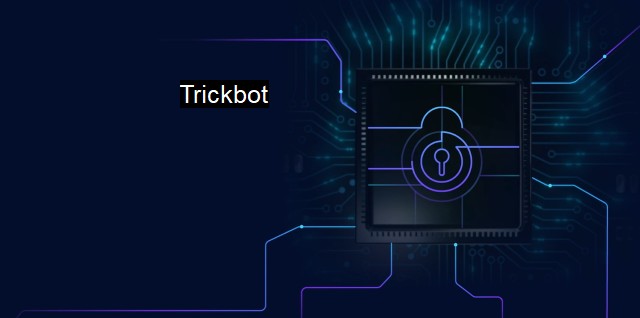What is Trickbot?
TrickBot: A Sophisticated and Evolving Banking Trojan with Advanced Capabilities and Endless Reach
TrickBot is a formidable player in the cyber threat landscape. This malicious software, also known as malware, first surfaced around mid-2016 and has since evolved into one of the most prevalent cyber threats in the world. By leveraging advanced evasion techniques and progressive programming, TrickBot has become synonymous with causing chaos and havoc in both personal and enterprise systems around the globe.TrickBot is a modular banking trojan that's built for perpetuating financial fraud cybercrimes. Designed as an advanced variant of the famous Dyre trojan, TrickBot gained early notoriety for distributing itself via malicious email campaigns and exploiting software vulnerabilities. Typically, the cyber target faces an onslaught of what appear to be regular, ordinary invoices or bills which, after a seemingly innocent click, deploy the dangerous threat into their system.
Inside the host system, TrickBot wreaks havoc by predominantly targeting banking activities. Using redirection attack techniques, the malware intercepts the victim's online banking sessions and reroutes them to a deceptive look-alike page controlled by the cybercriminals. The confidential data entered on these pages, such as credentials, card data, and PINS, are then, consequently, in the hands of cybercriminals, paving the way for potential financial losses.
Over time, TrickBot has evolved and expanded its capabilities beyond banking trojans, making it a major risk in cybersecurity. Now, it can propagate across networks, damaging crucial infrastructure, stealing sensitive information and installing other malicious programs such as Ryuk, a lethal ransomware strain. This 'tricksters versatility' has become the bane for cybersecurity experts worldwide. Each update of the malware includes a new set of “tricks”, making detection and diagnosis a nightmare for security professionals.
A solemn example of its potential harm occurred in late 2020 when it allegedly targeted election infrastructure leading to increased apprehensions during a critical time in America’s elections. While it did not significantly influence the election outcome, it showcased the potential capacity of the TrickBot network to instigate chaos in crucial situations.
Antivirus software plays a crucial role in safeguarding against TrickBot. Built to detect, restrict and prevent malware. due to the adaptive nature of TrickBot's encoding, identifying the threat through antivirus software alone could be challenging since the malware constantly modifies its code to avoid detection.
With the advancements in malware activities such as TrickBot, it's imperative to accompany the use of trustworthy antivirus software with robust cybersecurity measures like secure firewalls, hardened network structures, employing two-factor authentication for vital procedures, and education against phishing attacks. Training and awareness about potential threats is critical, given that TrickBot pirates often rely mainly on human error for deployment.
Another effective way to counter threats like TrickBot is through continuous system updates. Through the effective patching of all software and ensuring that the system runs the latest versions, Trojans such as TrickBot are less likely to infiltrate an organization or individual’s system.
Partnerships between multinational cybersecurity agencies are also critical in combating TrickBot. In 2020, collaboration between Microsoft and various other enterprises lead to the temporary disruption of TrickBot's operational servers, a landmark achievement in cyber warfare.
To wrap up, the struggle with TrickBot is representative of the challenges faced on the cybersecurity front today. The unfortunate truth is the fight against cyber threats is ongoing and it’s the collective responsibility of individuals, government bodies, and private corporations alike to prioritize cybersecurity measures and bring it to the forefront of their operational focus.

Trickbot FAQs
What is Trickbot and how does it work?
Trickbot is a dangerous banking Trojan that is designed to steal sensitive information from victims' computers. It typically spreads through spam emails, malicious attachments or links, and infected websites. Once installed, Trickbot can steal login credentials, personal information, and financial data, as well as download additional malware or launch ransomware attacks. It also has the ability to spread laterally through networks and evade detection by security software.How can I protect myself from Trickbot malware?
To protect yourself from Trickbot and other malware, you should keep your antivirus and security software up-to-date and run regular scans. It's also important to avoid clicking on suspicious emails, attachments or links, and to only download software from reputable sources. Additionally, you can use email filters, firewalls, and other security tools to block incoming threats and monitor network activity.What are the consequences of a Trickbot malware infection?
The consequences of a Trickbot infection can be severe and long-lasting. Victims can suffer financial losses, identity theft, and damage to their reputation. Trickbot can also compromise sensitive data and systems, leading to business disruption, regulatory fines, and legal liabilities. In addition, Trickbot can infect other computers on the network, putting the entire organization at risk.What should I do if my computer is infected with Trickbot?
If you suspect that your computer is infected with Trickbot, you should immediately disconnect it from the network and turn it off. Then, seek the assistance of a cybersecurity expert to remove the malware and restore your system. It's important not to try to remove Trickbot yourself, as the malware is sophisticated and can be difficult to detect and eliminate. You should also change your login credentials and monitor your accounts for unusual activity.| | A | | | B | | | C | | | D | | | E | | | F | | | G | | | H | | | I | | | J | | | K | | | L | | | M | |
| | N | | | O | | | P | | | Q | | | R | | | S | | | T | | | U | | | V | | | W | | | X | | | Y | | | Z | |
| | 1 | | | 2 | | | 3 | | | 4 | | | 7 | | | 8 | | |||||||